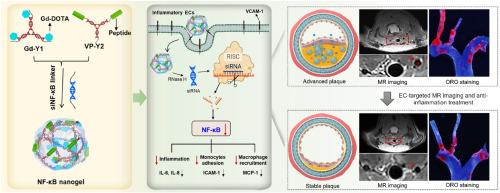Endothelium-targeted NF-κB siRNA nanogel for magnetic resonance imaging and visualized-anti-inflammation treatment of atherosclerosis
IF 12.8
1区 医学
Q1 ENGINEERING, BIOMEDICAL
引用次数: 0
Abstract
Atherosclerosis-induced lethal cardiovascular disease remains a severe healthcare threat due to the limited drug efficiency and untimely prediction of high-risk events caused by inadequate target specificity of medications, incapable recognition of insensitive patients, and variable morphology of vulnerable plaques. Therefore, it is necessary to develop efficient strategies to improve the diagnosis accuracy and achieve visualized treatment of atherosclerosis. Herein, we establish an inflamed endothelium-targeted three-in-one nucleic acid nanogel system that can reverse the inflammatory state of endothelial cells (ECs) in plaques and simultaneously achieve real-time monitoring of the therapy process for efficient atherosclerosis diagnosis and treatment. For this purpose, contrast agent (Gd-DOTA) and VCAM-1-targeted peptide (VP) are first covalently conjugated onto DNA strands by click reaction respectively, which could self-assemble into Y-shaped structures (Gd-Y1 and VP-Y2 motifs) with magnetic resonance (MR) imaging and endothelium targeting capacities. Thereafter, NF-κB subunit p65-targeting siRNA (siNF-κB) is crosslinked with Gd-Y1 and VP-Y2 motifs to construct the endothelium-targeting nanogel platform. With contrast agents inside, the nanogel enables MR-based diagnosis and visualized therapy of atherosclerosis, providing accurate prognostic analysis and indications for treatment results, which ensures timely disclosure of insensitive individuals and avoids acute lethal events. By delivering siNF-κB to inflammatory endothelium, the nanogel significantly regresses plaques in both the aorta and carotid artery with reduced inflammation cytokines, collagens, macrophages, and apoptotic cells, providing a potential anti-inflammation strategy to treat atherosclerosis and avoid acute cardiovascular disease.

用于动脉粥样硬化的磁共振成像和可视化抗炎治疗的内皮靶向 NF-κB siRNA 纳米凝胶。
由于药物的靶向特异性不足、无法识别不敏感患者以及易损斑块的形态多变,导致药物疗效有限且无法及时预测高危事件,动脉粥样硬化引发的致命性心血管疾病仍是严重的医疗威胁。因此,有必要开发有效的策略来提高诊断的准确性,实现动脉粥样硬化的可视化治疗。在此,我们建立了一种以炎症内皮细胞为靶点的三合一核酸纳米凝胶系统,它能逆转斑块中内皮细胞(EC)的炎症状态,同时实现对治疗过程的实时监控,从而达到高效诊断和治疗动脉粥样硬化的目的。为此,首先通过点击反应将造影剂(Gd-DOTA)和 VCAM-1 靶向肽(VP)分别共价键合到 DNA 链上,从而自组装成具有磁共振(MR)成像和内皮靶向能力的 Y 型结构(Gd-Y1 和 VP-Y2 motifs)。随后,NF-κB 亚基 p65 靶向 siRNA(siNF-κB)与 Gd-Y1 和 VP-Y2 基团交联,构建内皮靶向纳米凝胶平台。该纳米凝胶内含造影剂,可对动脉粥样硬化进行基于磁共振的诊断和可视化治疗,提供准确的预后分析和治疗结果指示,确保及时披露不敏感人群,避免急性致死事件的发生。通过向炎症内皮细胞递送 siNF-κB,纳米凝胶能显著消退主动脉和颈动脉的斑块,减少炎症细胞因子、胶原蛋白、巨噬细胞和凋亡细胞,为治疗动脉粥样硬化和避免急性心血管疾病提供了一种潜在的抗炎策略。
本文章由计算机程序翻译,如有差异,请以英文原文为准。
求助全文
约1分钟内获得全文
求助全文
来源期刊

Biomaterials
工程技术-材料科学:生物材料
CiteScore
26.00
自引率
2.90%
发文量
565
审稿时长
46 days
期刊介绍:
Biomaterials is an international journal covering the science and clinical application of biomaterials. A biomaterial is now defined as a substance that has been engineered to take a form which, alone or as part of a complex system, is used to direct, by control of interactions with components of living systems, the course of any therapeutic or diagnostic procedure. It is the aim of the journal to provide a peer-reviewed forum for the publication of original papers and authoritative review and opinion papers dealing with the most important issues facing the use of biomaterials in clinical practice. The scope of the journal covers the wide range of physical, biological and chemical sciences that underpin the design of biomaterials and the clinical disciplines in which they are used. These sciences include polymer synthesis and characterization, drug and gene vector design, the biology of the host response, immunology and toxicology and self assembly at the nanoscale. Clinical applications include the therapies of medical technology and regenerative medicine in all clinical disciplines, and diagnostic systems that reply on innovative contrast and sensing agents. The journal is relevant to areas such as cancer diagnosis and therapy, implantable devices, drug delivery systems, gene vectors, bionanotechnology and tissue engineering.
 求助内容:
求助内容: 应助结果提醒方式:
应助结果提醒方式:


